Early NYC cases fueled by multiple introductions from diverse origins. Community spread mainly linked to European and domestic introductions.
Follow @PapersCovidA recent preprint does some genetic detective work to try to paint a picture of early introduction and spread of SARS-CoV-2 in New York City. They looked at the genome of virus isolates from 84 patients between Feb 29 and March 18 to do an analysis similar to one done for Seattle earlier.
Overall they find
These genomes provide clear evidence for multiple, independent SARS-CoV-2 introductions into NYC during the first weeks of March
They also found that early self-quarantine measures were helpful in a sense
Cases with a history of travel exposure showed no evidence of onward transmission, supporting the efficacy of self-quarantine measures.
The majority of the introductions seem to have come from Europe and the US
You can see their inferred origins below


How they can know
Trevor Bedford describes the way this detective work is done in a blog post but the gist is that viruses mutate all the time (often in ways that don’t effect function). Given an estimate of how often these mutations occur, we can look at two nearby cases, see how many mutations have occurred between them and use this as a “molecular clock” to tell us how long ago the two versions of the virus had an ancestor in common. The evolutionary tree of a virus plus its mutation rate allows us to infer timing.
Overall, the takeaway from the authors are that travel restricions were likely of limited use given both the success of self-quarantine, whereas untracked transmission drove a large amount of spread (i.e. more testing would have been helpful).
Our data provide insight into the limited efficacy of travel restrictions for preventing spread of SARS-CoV2 infections in NYC, and point to the increased risk of community driven transmission within the larger metropolitan area.
